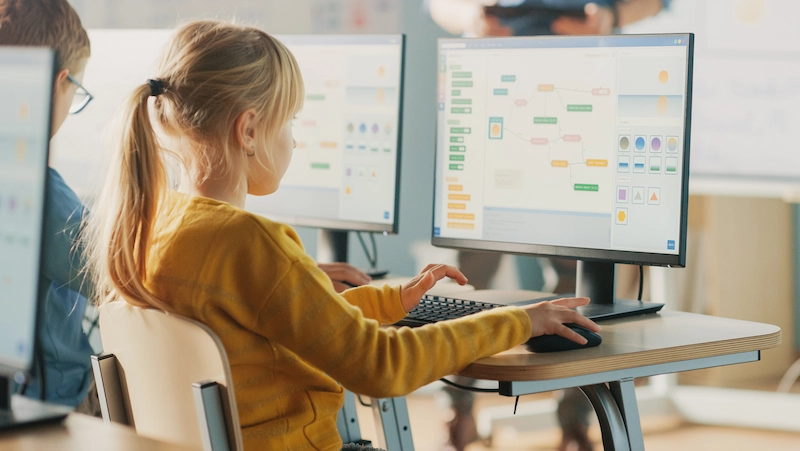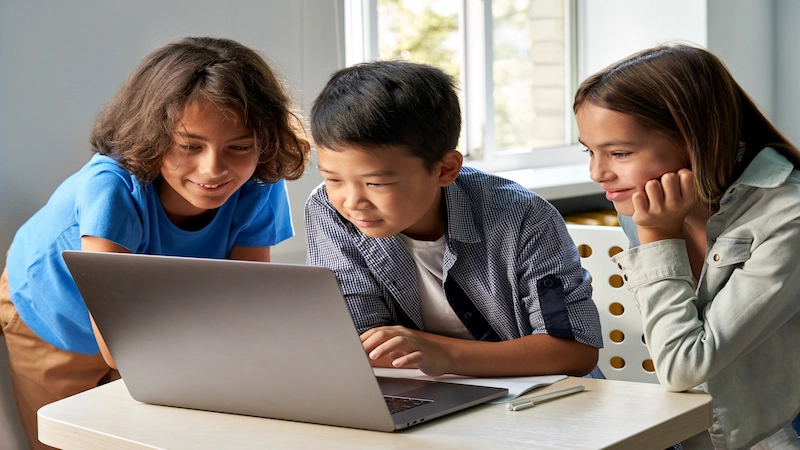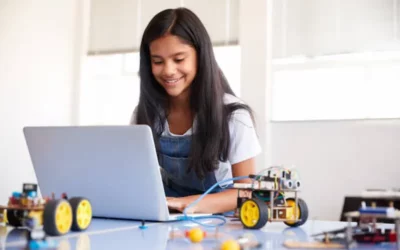Coding classes for kids are a gateway to the exciting world of technology and innovation. In today’s digital age, acquiring coding skills is essential for young minds to navigate and shape the future. These classes provide a dynamic and engaging environment where children can unleash their creativity and develop logical thinking abilities. Kids learn the fundamental concepts of programming, gaining the ability to create games, websites, and even build robots. They develop computational thinking skills, breaking down complex problems and finding innovative solutions. Coding classes empower children to become creators, problem solvers, and innovators.
Table of contents
- Benefits of learning to code at a young age
- Websites for Learning to Code for Free
- Online Coding Communities
- YouTube Channels for Learning to Code
- Coding Classes and Workshops Offered by Libraries
- How to Choose the Right Free Coding Classes for Your Child
- How to Support Your Child’s Coding Journey at Home
- Conclusion
- Frequently Asked Questions

Coding skills are becoming more and more valuable in the job market in today’s quick-paced digital age. The ability to code is now regarded as a vital skill that can improve employment chances and offer up a range of opportunities, from typical tech roles to non-technical positions.
In this blog, we’ll look at the factors behind the strong demand for coding abilities and talk about how these skills have evolved into a necessity across a range of sectors.
The Digital Transformation Era
The era of fast digital transition is the one in which we currently live. Technology is changing every industry, from automation and artificial intelligence to data analytics and cybersecurity.
Organizations need experts who are familiar with these technical developments as they work to maintain their competitiveness. This digital revolution is driven by coding, which makes it possible to create and apply creative solutions to challenging issues.
Tech Skills Gap
This is one of the main reasons why coding skills are becoming more and more important. There is a large employment gap as a result of the vastly greater demand than supply for technology experts.
There is a shortage of skilled applicants for tech-related professions, according to a number of reports, and this gap is expected to grow in the upcoming years. Employers are actively looking for people with coding abilities to close this skill gap and satisfy the rising demand for IT knowledge.
Versatility and Adaptability
Coding abilities are incredibly flexible and adaptable, going beyond conventional limitations. Coding is necessary for engineering and software development jobs, but its importance goes far beyond these fields.
Coding is used in many different industries in the linked world of today, including finance, healthcare, marketing, design, and even the arts. It gives professionals the ability to automate processes, analyze data, design websites and mobile applications, and develop solutions that are specialized to the demands of a given business.
The ability to code provides people with a useful toolkit that may be used in a variety of work situations.
Problem-Solving and Critical Thinking
Coding fosters problem-solving and critical thinking skills for kids in addition to teaching you how to write lines of code. When coding, people learn how to divide difficult problems into smaller, more manageable jobs.
They learn to think logically, analyze issues, and apply original solutions. Regardless of the industry, these problem-solving skills are highly recognized in the employment market. Coding abilities foster a mindset of lifelong learning, flexibility, and resourcefulness, making people more adaptable and successful in their careers.
Benefits of learning to code at a young age
While coding may seem daunting to some, it is a remarkable tool that opens up a world of opportunities and benefits, especially when acquired at a young age. By introducing children to coding early on, we empower them to become creators, problem-solvers, and innovators of the future.
Nurturing Creativity and Logical Thinking
Teaching young brains to code improves their capacity for both creativity and rational thought. Analytical and methodical thinking is developed by breaking down big problems into smaller, more manageable pieces when coding.
It encourages youngsters to question assumptions, try new things, and come up with creative answers to problems. Children may express their creativity and bring their ideas to life by making interactive projects, which feeds their zeal for exploration and learning.
Developing Problem-Solving Skills
Beginning at a young age, coding encourages a problem-solving approach. The capacity to recognize issues, investigate them, and develop rational solutions are necessary for programming.
As they learn to debug their programs and overcome challenges, children who learn to code grow in resilience and tenacity. Beyond coding, these problem-solving abilities become useful advantages in a variety of facets of life, including academics, interpersonal connections, and potential employment.
Fostering Computational Thinking
Coding is a key skill that helps people develop computational thinking. It entails reducing complicated problems into manageable parts and solving them logically. Children learn how to approach problems in a disciplined, methodical way using computational thinking.
This method of thinking supports their capacity for knowledge organization, analysis, and interpretation, empowering them to take well-informed judgments and effectively handle challenging situations.
Enhancing Math and Science Skills
Learning to code improves mathematical and scientific aptitude. Mathematics-related ideas like patterns, sequences, variables, and logical operations are used in coding. Children who learn to code engage in practical learning experiences that help them grasp math’s and science better.
Coding is an interesting way to learn about and enjoy STEM topics because projects requiring it frequently involve the application of scientific principles.
Websites for Learning to Code for Free

Coding is now a necessary talent in the digital age, enabling people to make their ideas a reality and providing access to a wide range of opportunities. Learning to code is an essential step whether you want to construct websites, develop mobile apps, or get into data analysis.
The good news is that learning to code doesn’t have to cost a fortune. We’ll look at some of the top websites that provide free coding materials in this article, making it possible for anyone with an internet connection to start learning to code.
BrightCHAMPS
CodeChamps by BrightChamps is an extraordinary coding program that ignites young minds with the power of coding through an engaging curriculum. It is a creative wonderland where kids dive into the captivating world of programming, learning to unravel complex algorithms and craft their own digital masterpieces. With a holistic curriculum, CodeChamps nurtures the innate problem-solving abilities of children, fostering their creativity and critical thinking. CodeChamps is where dreams come alive, and the future of innovation takes flight.
Code.org
A nonprofit organization called Code.org is committed to increasing access to computer programming for kids science education. It provides a thorough platform for students of all ages and skill levels.
Programming ideas are gradually introduced through interactive tutorials and coding tasks on the website Code.org. “Hour of Code,” a collection of one-hour coding tasks made to educate newcomers to code in a fun and engaging way, is one of its most well-known offerings.
For both children and adults wishing to learn how to code, Code.org is a great place to start thanks to its extensive curriculum and tools.
Scratch
Scratch is a great option if you’re new to coding and searching for a visually appealing and user-friendly environment. Scratch is a block-based coding environment that explains programming concepts.
It was created by the Lifelong Kindergarten Group at the MIT Media Lab. By connecting vibrant code pieces, users may make interactive stories, games, and animations. Beginners can concentrate on logic and creativity in Scratch’s drag-and-drop environment without becoming bogged down by syntax.
Scratch fosters community among learners by promoting collaboration and project sharing through an encouraging online community.
Khan Academy
The well-known educational website Khan Academy also has a large selection of coding courses available. Their engaging coding tutorials include discussions on HTML basics, CSS, JavaScript, and other topics.
Fundamentals of programming are simple for novices to understand thanks to Khan Academy’s step-by-step lectures. The way that Khan Academy approaches coding assignments is unique, pairing them with video explanations.
This combination aids students in comprehending and successfully applying the underlying ideas. The user-friendly design of Khan Academy and its extensive curriculum make it the perfect tool for self-paced study.
freeCodeCamp
A nonprofit organization called freeCodeCamp seeks to increase accessibility to coding education for all people. The programme offers a comprehensive curriculum that includes front-end and back-end web development as well as data science and other relevant subjects.
FreeCodeCamp stands out due to its focus on practical application. In order to get real-world experience while having a good influence, students collaborate on projects for charitable organisations.
Additionally, freeCodeCamp offers a helpful community forum where students may ask questions and get in touch with other programmers.
Coursera and edX
A variety of free coding courses are available through the online learning platforms Coursera and edX, which collaborate with famous universities and organisations. On these platforms, experts from universities like Stanford, Harvard, and MIT offer classes on everything from basic programming to advanced subjects.
Even though some courses on these sites have extra features or need money for certificates, it is still possible to audit the courses for free. For those looking for a more structured, high-quality learning environment, Coursera and edX are excellent options.
Online Coding Communities

In today’s fast-paced digital era, coding has emerged as an essential skill that empowers individuals to thrive in a technology-driven world. Recognizing the significance of coding education for children, online coding communities have become an invaluable resource.
These communities foster a supportive and interactive environment, enabling young learners to embark on a journey of creativity, problem-solving, and innovation. In this blog, we will explore the concept of online coding communities and the numerous benefits they offer to children learning to code.
Access to a Diverse Learning Environment
Online coding communities bring together aspiring coders from around the world, creating a diverse learning environment. Children get the opportunity to interact with peers who share their passion for coding, fostering collaboration and the exchange of ideas.
This exposure to different perspectives enhances their problem-solving skills and encourages out-of-the-box thinking.
Supportive and Engaging Community
Learning to code can sometimes be a daunting task, especially for young learners. Online coding communities provide a supportive network of mentors, teachers, and fellow learners who are ready to offer guidance and assistance.
Children can ask questions, seek help, and receive feedback on their projects, ensuring they never feel alone in their coding journey. The sense of community also promotes motivation, as children celebrate each other’s achievements and milestones.
Gamified Learning Experience
Many online coding communities incorporate gamification elements into their learning platforms. Through interactive challenges, badges, and leaderboards, children are motivated to complete coding tasks and progress through different levels.
Gamification adds an element of fun and competition, making the learning experience enjoyable and engaging. It encourages children to persist in their coding endeavors, boosting their confidence and perseverance.
Project-Based Learning
Online coding communities often emphasize project-based learning, where children work on real-world coding projects. This hands-on approach allows them to apply their knowledge to practical scenarios, fostering a deeper understanding of coding concepts.
By building their own projects, children gain a sense of ownership and accomplishment, as they witness their code come to life. Moreover, they can showcase their projects to the community, receiving valuable feedback and recognition for their efforts.
Continuous Learning and Skill Development
Coding is a field that is constantly evolving, and online coding communities provide a platform for continuous learning and skill development. Children can access a wide range of resources, tutorials, and coding challenges that cater to different skill levels.
As they progress, they can explore advanced topics, participate in coding competitions, and even contribute to open-source projects. The communities ensure that children are equipped with the latest coding skills, preparing them for future opportunities in technology.
YouTube Channels for Learning to Code

In recent years, YouTube has become a potent tool for self-improvement and learning across a wide range of subject areas. The coding education sector is one that has grown significantly on YouTube.
There are now a tonne of YouTube channels available for teaching programming languages, frameworks, and problem-solving strategies to aspiring programmers and coding aficionados. In this blog, we’ll examine the expanding practice of using YouTube as a coding learning tool and talk about how it may be used to improve one’s coding abilities.
Accessible and Engaging Content
When it comes to accessibility and engagement, YouTube has an unmatched advantage. YouTube channels for learning to code offer a visual and interactive learning experience, in contrast to traditional instructional materials.
Complex programming concepts can be more easily grasped and understood by viewers through the use of video courses, coding challenges, and demonstrations.
Diverse Range of Coding Topics
When it comes to accessibility and engagement, YouTube has an unmatched advantage. YouTube channels for learning to code offer a visual and interactive learning experience, in contrast to traditional instructional materials.
Complex programming concepts can be more easily grasped and understood by viewers through the use of video courses, coding challenges, and demonstrations.
Community Interaction and Support
The vibrant community of students and educators on YouTube is one of its most notable qualities. Learning to code platforms frequently enable vibrant communities of like-minded people who share experiences, provide assistance, and participate in conversations about coding.
This sense of community fosters a helpful environment where students may ask for assistance, work together on projects, and pick the brains of more seasoned programmers.
Real-World Applications and Project-Based Learning
The vibrant community of students and educators on YouTube is one of its most notable qualities. Learning to code platforms frequently enable vibrant communities of like-minded people who share experiences, provide assistance, and participate in conversations about coding.
This sense of community fosters a helpful environment where students may ask for assistance, work together on projects, and pick the brains of more seasoned programmers.
Flexibility and Self-Paced Learning
YouTube’s on-demand nature provides learners with unmatched freedom. You can access code tutorials whenever it’s most convenient for you, regardless of whether you’re a student, a working professional, or someone with a busy schedule.
With YouTube, you’re free to study at your own pace, pause, rewind, and go over ideas again as needed. This method of self-paced learning guarantees a customized educational experience that changes depending on each student’s requirements and choices.
Top YouTube Channels for Kids to Learn Coding
While there are numerous resources available to learn coding, YouTube channels have emerged as a popular and interactive platform for kids to delve into the world of programming. In this blog post, we will highlight some of the best YouTube channels for kids to learn to code, featuring channels like CS First and The Coding Train.
CS First
Google created the free computer science program CS First for elementary and middle school students. A variety of coding principles are covered in interesting movies on the linked YouTube channel using the user-friendly visual programming language Scratch.
Kids may learn how to code while experimenting with different projects because to CS First’s emphasis on establishing a pleasant and engaging learning environment.
The Coding Train
The Coding Train is a well-known YouTube program run by Daniel Shiffman that strives to make coding approachable and fun for everyone, even children. Shiffman teaches viewers to programming languages like JavaScript and Python coding for kids with a focus on creative coding.
Kids can learn to code in an engaging and hands-on way thanks to the channel’s tutorials, coding challenges, and live coding sessions.
Coding Garden with CJ
CJ runs the YouTube channel Coding Garden with CJ, where he streams coding sessions and works on projects in real-time. The channel serves a broad audience, but it also has helpful material for aspiring young programmers. CJ discusses JavaScript, web development, and related technologies while providing useful coding examples that promote hands-on learning.
Kids can connect with CJ and ask questions throughout the streams thanks to the live chat option.
Khan Academy
The well-known educational platform Khan Academy offers a specific YouTube channel devoted to computer science and coding. Their programming lessons cover a wide range of languages, such as HTML, CSS, and JavaScript.
The videos from Khan Academy are well-organized and offer interactive coding activities as well as step-by-step tutorials. The channel is a useful tool for aspiring programmers because it also offers courses on algorithms, game design, and data visualization.
Coding Classes and Workshops Offered by Libraries

Coding and computer literacy are becoming increasingly crucial abilities in today’s technologically advanced world. Recognizing this, libraries all throughout the country have stepped up to offer their communities coding lessons and workshops.
In addition to promoting digital literacy, these projects give people the keys to new opportunities in the digital age. In this blog article, we’ll examine the variety of coding workshops and classes that your neighborhood libraries offer while stressing their importance and effects.
Introduction to Coding
For those with little to no coding expertise, libraries frequently offer introductory coding sessions. Using approachable platforms and languages, these courses give students a solid foundation in programming ideas.
Participants pick up the fundamentals of coding logic, as well as how to solve problems and write straightforward programs. These seminars empower people to discover the fascinating world of technology by demystifying coding.
Web development and design
Libraries also provide seminars on these topics, teaching participants how to build websites and design user-friendly interfaces. These courses typically include HTML, CSS, and JavaScript, giving students the foundational knowledge needed to create attractive and useful websites.
People can express their creativity and even seek jobs in web development thanks to these workshops.
Mobile App Development
Libraries are gearing up to teach mobile app development in response to the rising popularity of smartphones. With the help of these classes, participants may learn by doing as they develop their own apps for the iOS or Android platforms.
A person can design apps and potentially contribute to the expanding app economy by learning how to implement their creative ideas.
Data Science and Analytics
In the current data-driven world, libraries are also realising the significance of data science and analytics. Participants are introduced to the tools and methods used for data analysis and visualisation during workshops in this field.
Participants gain experience working with well-known programming languages like Python and R, enabling them to draw insightful conclusions from huge datasets. These abilities are in high demand across a range of industries and may open up intriguing employment options.
Coding for Kids and Teens
Numerous libraries provide designed especially for young people coding courses for kids. Early coding interest is encouraged in these sessions, which also foster computational thinking and problem-solving skills.
Young participants learn programming fundamentals in a fun and approachable way through interactive and interesting activities. Libraries are playing a significant part in educating the younger generation for the future job market by teaching coding to them.
Collaborative Coding Projects and Hackathons
Libraries frequently host hackathons and collaborative coding projects that provide participants the chance to collaborate on real-world coding difficulties. These gatherings promote a sense of community and teamwork while enabling people to improve their coding abilities and tackle important issues.
Hackathons are also venues for invention where participants may display their originality and create answers to social problems.
How to Choose the Right Free Coding Classes for Your Child

Coding abilities are becoming more and more crucial for kids in the modern digital world. Along with improving problem-solving skills, learning to code also fosters creativity and critical thinking.
Thankfully, there are several free coding classes available to assist kids in acquiring these abilities. However, parents may find it difficult to make the proper choice.
We will discuss the elements to take into account when choosing free coding lessons for your child in this blog post, such as their age, ability level, and learning style.
Age Appropriateness:
It’s important to take your child’s age into account when looking for free coding classes. Since teaching strategies and curricula vary according to age groups, programming courses are frequently designed for those groups.
Interactive, visual programming environments that prioritize playfulness and simplicity may be beneficial for younger children. Older children might be prepared for more sophisticated concepts and language. To keep your child interested and challenged, look for coding lessons that are appropriate for their age.
Skill Level:
Assessing your child’s present level of coding proficiency is crucial for picking the right classes. Courses that start from scratch, concentrate on core ideas, and lay a strong foundation are necessary for beginners.
On the other hand, learners who are intermediate or advanced may require harder subjects and assignments. Finding the best class for your child’s ability is made easier by the many coding platforms that include tests or skill level indicators.
Learning Style
Children have a variety of learning styles, therefore taking this into account will help them succeed in coding classes. While some youngsters might do better in a more conventional classroom setting, others could prefer visual and interactive coding platforms.
Investigate several teaching strategies, including interactive coding games for kids, live instruction, and video tutorials, to find the one that best fits your child’s learning preferences. Consider their preferred learning pace as well, including whether they prefer self-paced learning or thrive in an organized atmosphere.
How to Support Your Child’s Coding Journey at Home

Children need to learn how to code in order to succeed in today’s technologically advanced society. Children gain creativity, critical thinking, and problem-solving skills through learning to code.
You can help your child develop their love of technology and boost their coding education by supporting them as a parent. In this blog, we’ll go through a number of methods you may encourage and empower your kid’s path into coding from the comfort of your own home.
Create a supportive learning environment
It’s crucial to create a supportive environment at home for your youngster to continue learning to code. Create an area just for them, complete with a laptop or computer and a cozy chair. Reduce interruptions and make the environment peaceful and well-lit so that they can concentrate on their coding work.
Give your child access to coding resources and tools
Your child’s education in coding depends on having access to the appropriate resources and tools. There are many websites and online platforms made expressly for teaching coding to kids in a fun and engaging way. The programmes BrightCHAMPS, Scratch, Code.org, and Tynker are a few well-liked choices. These websites provide tutorials for complete beginners, coding challenges, and project suggestions for people of all ages.
Encourage exploration and independent learning
Coding is an iterative process that involves experimentation and problem-solving, therefore promoting exploration and independent learning. Encourage your child to research various coding languages and concepts independently.
Allow them to take the initiative and figure out answers to coding puzzles on their own. This encourages kids curiosity, independence, and tenacity, which are necessary traits for mastering coding.
Engage in coding activities together
Cooperative learning is crucial, but you can also actively support your child’s coding journey by participating in activities together. Work on tiny projects, solve coding riddles, or even create a basic website as a group to engage in coding activities.
This not only solidifies your relationship with them but also shows that you care about how they are learning.
Promote their initiatives and their output
Applying knowledge to practical projects is an important part of learning to code. Whether it’s developing a game, a website, or an app, encourage your youngster to work on coding projects of their choosing.
Ask inquiries, express interest in their ideas, and offer helpful criticism. Celebrate their successes and assist them in showcasing their efforts to loved ones. Online coding classes for kids provide structured environments where these supportive practices can enhance learning and engagement, fostering both skill development and confidence in young learners.
Conclusion
As parents, it’s crucial to recognize the importance of coding as a fundamental skill for the future. By encouraging our children to explore these free coding resources, we can equip them with the tools they need to thrive in an increasingly digital world.
We have the power to inspire their curiosity, support their learning journey, and help them discover their potential without straining our budgets.
So, let’s embrace the multitude of free coding resources available and empower our children to unlock the world of coding. Together, we can cultivate a generation of innovative thinkers, problem solvers, and creators, all while keeping our wallets happy. The possibilities are endless, and the future is bright for our little coders!
Remember, learning to code doesn’t have to break the bank. It only takes a spark of curiosity, a willingness to explore, and the right free resources to set our children on a path to coding greatness. Let’s embark on this exciting journey with them and watch their coding skills soar!
Frequently Asked Questions
Absolutely! There are numerous resources available online that offer free coding lessons and tutorials designed specifically for kids.
Children as young as five or six can begin learning coding concepts through age-appropriate platforms and tools. However, the ideal starting age may vary based on individual interests and capabilities.
Some popular websites that offer free coding classes for kids include Code.org, Scratch, Khan Academy, and MIT App Inventor. These platforms provide interactive and engaging coding lessons.
Yes, many online coding communities have measures in place to ensure the safety of children. These communities often have moderated forums and strict guidelines to promote a positive and secure learning environment.
Some highly recommended YouTube channels for kids to learn coding are Code with Anna and Elsa, Scratch Garden, and KidsCanCode. These channels offer fun and educational coding content for young learners.
Check your local library’s website or inquire in person to discover coding classes and workshops available.
The effectiveness of coding classes can vary, regardless of whether they are free or paid. It depends on the quality of instruction and the individual’s dedication to learning.
Encourage your child to explore online coding resources, provide access to coding platforms, and consider enrolling them in online coding courses or coding clubs.
Yes, learning to code can greatly benefit your child’s future career prospects as coding skills are in high demand across various industries.
The cost of paid coding classes for kids can vary significantly, ranging from affordable options to more expensive programs. It is advisable to research and compare prices from different providers to find one that fits your budget.

 We are an army of educators and passionate learners from BrightChamps family, committed to providing free learning resources to kids, parents & students.
We are an army of educators and passionate learners from BrightChamps family, committed to providing free learning resources to kids, parents & students.








